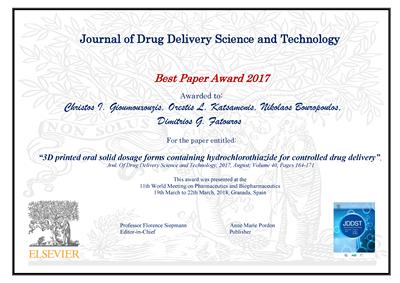
Delighted to see our article entitled: "3D printed oral solid dosage forms containing hydrochlorothiazide for controlled drug delivery" by C. Gioumouxouzis et al. to have been selected by the Journal of Drug Delivery Science and Technology as the "Most outstanding JDDST research article in 2017".
The award was announced in public at the 11th World Meeting on Pharmaceutics, Biopharmaceutics and Pharmaceutical Technology, held on 19 -22 March 2018 in Granada.
Reference: Gioumouxouzis, C. I., Katsamenis, O. L., Bouropoulos, N., & Fatouros, D. G. (2017). 3D printed oral solid dosage forms containing hydrochlorothiazide for controlled drug delivery. Journal of Drug Delivery Science and Technology, 40, 164-171
Abstract: 3D printing has been recently employed in the design and fabrication of medicine, aiming to improve their properties and release behavior. In the current work an oral solid dosage formwas created by Fused Deposition Modeling (FDM), using a custom built filament comprised of a water soluble polymer polyvinyl alcohol (PVA), mannitol and hydrochlorothiazide(HCTZ) as model drug and further co-formulated via Hot-Melt Extrusion (HME). This composition was printed as the inner part of a three-compartment hollow cylinder dosage form using a dual extrusion 3D FDM printer, whereas the outer parts of the formulation consisted of water-insoluble polylactic acid (PLA). The produced formulations were characterized by means of differential scanning calorimetry (DSC), X-ray diffraction (XRD) and thermogravimetric analysis (TGA). Release studies were performed in pH 1.2 and 6.8 whereas time-lapsed X-ray microfocus Computed Tomography (4D-CT), was employed to visualize volumetric and morphological changes of the formulations during the dissolution procedure. The results showed that HCTZ was incorporated in the amorphous state. Dissolution studies demonstrated that HCTZ exhibited zero-order kinetics whereas 4D-CT revealed a bi-directional smooth and homogenous reduction of PVA further corroborating the dissolution studies. The results showed that FDM printing might be used to ‘fine tune’ the release of drug molecules.